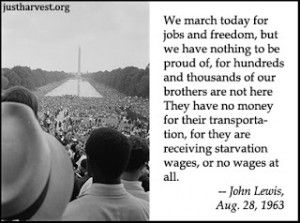If we want to honor the Great March on Washington that took place fifty years ago today, we shouldn’t limit ourselves to nostalgia and reciting speeches. We should work to fulfill the concrete economic justice demands of the marchers.
The news media and the public, across the political spectrum, have given tremendous attention in recent days to the historic event. This attention has included an anniversary march and rally at the Lincoln Memorial, frequent news clippings of Dr. King’s speech, interviews with civil rights movement heroes, and retrospectives on our nation’s progress towards racial inclusiveness.
But precious little attention has been paid to the fact the official policy goals of the March on Washingtonfor Jobs and Freedom – as it was called at the time – were not only about civil rights and the end of racial discrimination.
Organizers of the March had set nine specific goals for the actions that the federal government should take to address “Jobs and Freedom.” Six of these goals were explicitly about civil rights, and have, over the past half-century, been largely achieved.
But the March on Washington explicitly called for three other goals that were aimed at basic economic opportunity for all Americans. These remain largely unfulfilled.
Yes, I suppose the Marchers succeeded. The minimum wage, which was $1.25 per hour at the end of 1963, finally reached $2.00 eleven years later. Today, it is a whopping $7.25 which, according to the Bureau of Labor Statistics Inflation Calculator, is equivalent to $0.95 in 1963. Adjusted for inflation, the $2.00/hour demand of the Marchers fifty years ago would equal $15.25 now. Just slightly more than the $15.00 demanded at recent rallies and strikes targeting the fast food industry.
The protesters at the McDonald’s in Pittsburgh and across the nation are the heirs of the marchers, continuing the unfinished business of 1963. Imagine if they were joined by 250,000 companions at the mall in Washington, with headlines and live TV network coverage for their demand for a $15.25 minimum wage. Perhaps just like in 1963, their opposition in Congress would smear the march as “communist-inspired.”
The news is not too bad here, as many farmworkers received Fair Labor Standards Act protection in 1966 and many domestic service workers won FLSA coverage in 1974. But farmworkers who are “traditionally” paid piecemeal for their work still get no overtime. Some home health aides defined by the law as providing “companionship” services have no minimum wage or overtime rights. And untold thousands of workers are routinely exploited by workplaces abuses such as falsified timecards and being misclassified as “independent contractors” in jobs from child care to trucking to construction.
Direct government hiring of unemployed people to do Public Works hasn’t happened since the Franklin Roosevelt administration. Not even today’s “liberals” in Congress dare to put such an extreme measure on the agenda. In August 1963, the official unemployment rate was 5.4%. Today, it is 7.4%. Instead of celebrating that it is down from its Great Recession peak of 10.0%, why doesn’t the Obama administration propose a massive public employment program?
And instead of arguing that the “stimulus didn’t work” – despite the fact that unemployment DID decline significantly as a result – why won’t Republicans, who claim to support the work ethic and the American dream of self-sufficiency, support such a stimulus plan? After all, some of them now want to impose work requirements on food stamp recipients. What part of “7.4% unemployment” don’t they understand?
And to those who argue that public works are a waste of money, I invite you to come for a walk with me some evening at the beautiful Highland Park Reservoir. Right there on the walkway to one of Pittsburgh’s great quality-of-life public assets is the stone inscription: “Built by the WPA.”
Yes, there is much unfinished business from August 28, 1963. After half a century, it is no longer time for dreams, but time to make real a day when our children will be judged by the content of their character, not by the contents of their wallets. The best way to honor the marchers is to join their fight to end all inequality.





No comments yet.